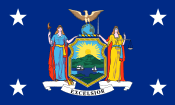Alonzo B. Cornell
| Alonzo B. Cornell | |
|---|---|
 | |
| 27th Governor of New York | |
|
In office January 1, 1880 – December 31, 1882 | |
| Lieutenant | George G. Hoskins |
| Preceded by | Lucius Robinson |
| Succeeded by | Grover Cleveland |
| Member of the New York State Assembly from the New York County, 11th district | |
|
In office January 1, 1873 – December 31, 1873 | |
| Preceded by | Rush C. Hawkins |
| Succeeded by | Knox McAfee |
| Personal details | |
| Born |
Alonzo Barton Cornell January 22, 1832 Ithaca, New York, U.S. |
| Died |
October 15, 1904 (aged 72) Ithaca, New York, U.S. |
| Political party | Republican |
| Profession | Politician, Businessman |
| Religion | Quaker |
Alonzo Barton Cornell (January 22, 1832 – October 15, 1904) was a New York politician and businessman who served as 27th Governor of New York from 1880 to 1882.
Early years
Born in Ithaca, New York, he was the eldest son of Ezra Cornell, the founder of Cornell University and Mary Ann (Wood) Cornell. He was educated at the Ithaca Academy.
Family
He was married to Esther Elizabeth Covert, a native of Auburn, New York on 9 November 1852.
Career
At the age of fifteen, he began a career in the field of telegraphy, later serving as a manager in telegraph office in Cleveland, Ohio. Afterwards, he owned steamboats on Cayuga Lake from 1862 to 1863. From 1864 to 1869 he was a cashier and vice president with the First National Bank of Ithaca. He was a director of the Western Union Telegraph Company, which had been co-founded by his father, from 1868 to 1876 and was its vice president from 1870 to 1876.
He was town supervisor of Ithaca in 1864-5. From 1858 until 1866, he served as chairman of the Tompkins County Republican committee, and in 1866-7 was a member of the Republican state committee. He was one of the first commissioners for the erection of the new state capitol at Albany from 1868 until 1871. He was the Republican candidate for Lieutenant Governor of New York in 1868, but was defeated by Democrat Allen C. Beach. He was appointed by President Ulysses S. Grant as Surveyor of the Port of New York.

From 1870 to 1878 he was chairman of the state Republican Party. He resigned his position as Surveyor of the Port of New York to become a member of the New York State Assembly (New York Co., 11th D.) in 1873, and was elected Speaker, one of the very few times a first-term member was chosen. He was influential at the 1876 Republican National Convention which nominated Rutherford B. Hayes. In January 1877, he was appointed naval officer of the Port of New York by Grant.
Hayes, upon becoming president, directed the Treasury Department to notify Cornell that he must resign from the state and national Republican committees as a condition of remaining naval officer. Regarding this as an invasion of his civil and political rights, Cornell declined to obey the mandate, whereupon a successor was nominated, but was rejected by the Senate. After the adjournment of the Senate in July 1878, Hayes suspended both the collector (Chester A. Arthur) and the naval officer, and their successors were finally confirmed. At the subsequent elections, Cornell was chosen Governor of New York and Arthur became Vice President of the United States.
Cornell was governor from 1880 to 1882, elected in 1879. His administration was noted for economy in public expenditures, and his vetoes of appropriation bills were beyond all precedent. Upon his recommendation, a state board of health and the state railroad commission were created, women were made eligible for school officers, a reformatory for women established, and the usury laws were modified.
The resignation of the New York senators from the U. S. Senate in 1881 provoked a bitter contest for the succession, by which the Republican Party was divided into hostile factions, the Stalwarts and the Half Breeds. Cornell's opponents prevented his re-nomination for governor.
Death and legacy
Although he lived in New York City during his latter years, Cornell died in Ithaca, New York, aged 72, and was interred with his father and mother in Sage Chapel on the Cornell University campus. He wrote a biography of his father in 1884. His papers are held in Cornell University Library's Division of Rare and Manuscript Collections.
Notes
References
- Alonzo B. Cornell at Find a Grave
 This article incorporates text from a publication now in the public domain: Wilson, James Grant; Fiske, John, eds. (1900). "Cornell, Ezra". Appletons' Cyclopædia of American Biography. New York: D. Appleton.
This article incorporates text from a publication now in the public domain: Wilson, James Grant; Fiske, John, eds. (1900). "Cornell, Ezra". Appletons' Cyclopædia of American Biography. New York: D. Appleton.
External links
| New York Assembly | ||
|---|---|---|
| Preceded by Rush C. Hawkins |
New York State Assembly New York County, 11th District 1873 |
Succeeded by Knox McAfee |
| Preceded by Henry Smith |
Speaker of the New York State Assembly 1873 |
Succeeded by James W. Husted |
| Political offices | ||
| Preceded by Lucius Robinson |
Governor of New York 1880–1882 |
Succeeded by Grover Cleveland |
| Party political offices | ||
| Preceded by Hamilton Harris |
Chairman of the New York Republican State Committee 1870–1874 |
Succeeded by Edwin D. Morgan |
| Preceded by Edwin D. Morgan |
Chairman of the New York Republican State Committee 1875–1877 |
Succeeded by John F. Smyth |
| Preceded by John F. Smyth |
Chairman of the New York Republican State Committee 1878–1879 |
Succeeded by Chester A. Arthur |
